Le 5 décembre 2024, Vichy Enchères aura l’honneur de proposer à la vente un archet d’exception signé Jean-Baptiste Vuillaume, une pièce unique dans l’histoire de l’archèterie. Ce modèle en métal, véritable prouesse technique et artistique, se distingue par sa rare particularité : sa hausse est ornée d’une représentation naturaliste d’un oiseau s’abreuvant – un motif inédit dans l’œuvre de Vuillaume. Chef-d’œuvre d’innovation et de raffinement, cet archet, unique dans l’œuvre de Vuillaume, l’est également dans l’histoire de l’archèterie, puisqu’il s’agit du seul instrument connu à présenter un tel décor. L’occasion pour nous de revenir sur l’audace créatrice dont Vuillaume fit preuve en archèterie…
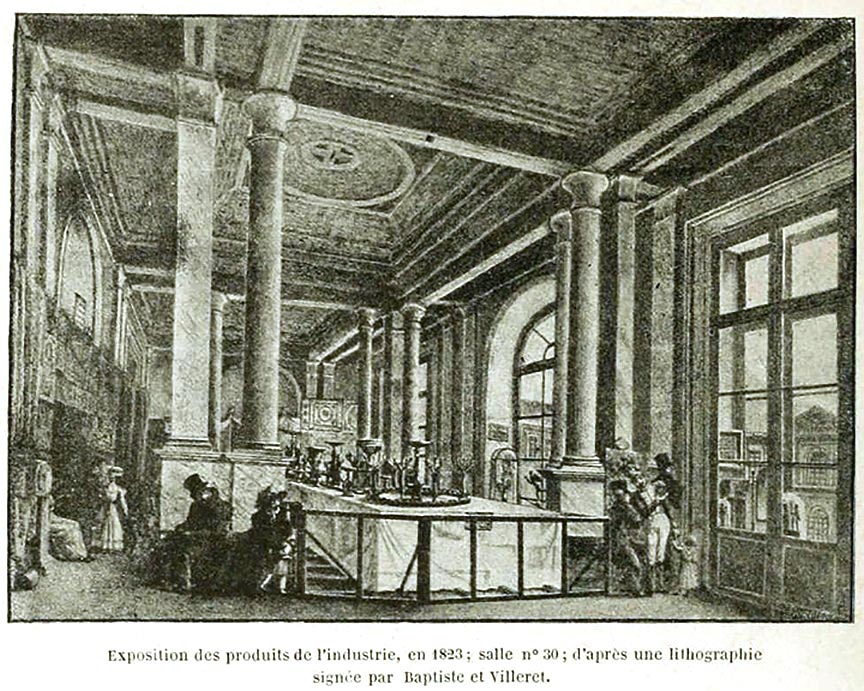
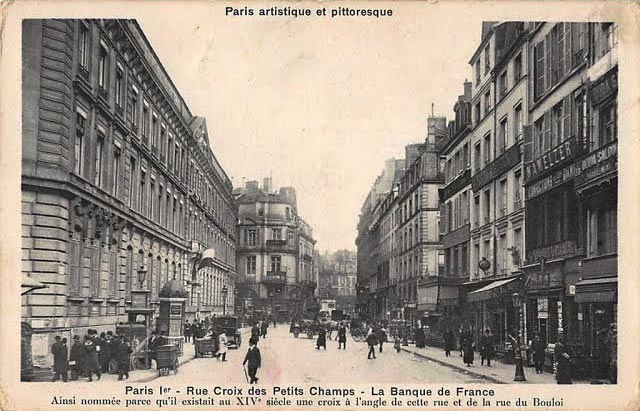
Né dans une famille de luthiers à Mirecourt, Jean-Baptiste Vuillaume (1798-1875) s’inscrit dans cette tradition familiale séculaire. Bien que nous ne soyons pas certains de l’identité de son maître, qui pourrait être Joseph Chanot, Nicolas Mathieu ou encore Simoutre père, on sait que Vuillaume quitta Mirecourt pour Paris en 1818, où il travailla d’abord pour François Chanot, puis Nicolas Antoine Lété. À Paris, son savoir-faire précoce fut rapidement remarqué.
Lété obtint une médaille à l’Exposition de Paris de 1823 pour un violon réalisé par Vuillaume, permettant au jeune luthier de signer ses œuvres sous son propre nom et d’accéder à une plus grande reconnaissance. En 1828, Vuillaume ouvre son propre atelier au 46 rue Croix-des-Petits-Champs, marquant ainsi le début de son ascension professionnelle dans le monde de la lutherie. Il se fait un nom en tant que luthier – ses violons étant comparés aux plus grands maîtres italiens que sont Stradivari et Guarneri – mais également en tant qu’innovant archetier.
Parmi les inventions les plus emblématiques de Vuillaume, l’archet à mèche interchangeable est un incontournable. Cette invention permettait aux musiciens de changer la mèche de leurs archets en toute autonomie, sans faire appel à un archetier. Il s’agissait d’une innovation particulièrement appréciée par les musiciens vivant dans des zones rurales ou éloignées, où l’accès à des archetiers était limité.
Le principe de cet archet était simple mais ingénieux : la mèche était sertie à ses deux extrémités dans des tubes en cuivre. Pour remplacer la mèche, il suffisait d’insérer ces tubes dans des fentes spécialement prévues dans la tête de l’archet et au niveau de la hausse. Le mécanisme de tension de la mèche, situé dans la hausse, permettait de la tendre à la convenance du musicien.
Vuillaume commercialisait ces archets accompagnés d’une boîte contenant plusieurs mèches de rechange, ainsi qu’un manuel d’instructions expliquant comment changer la mèche. Les instructions incluaient des conseils pratiques pour éviter que l’archet ne se déforme lors de l’installation de la mèche. En cas de gauchissement de l’archet après remplacement, il suffisait, selon Vuillaume, de retourner la mèche pour corriger le problème.
L’intérêt pour ce système fut notable, notamment chez les musiciens itinérants, qui pouvaient ainsi s’épargner les longs trajets vers les grandes villes pour faire remécher leurs archets. Cependant, l’invention avait aussi ses inconvénients. L’entaille réalisée dans la tête de l’archet pour accueillir le tube de la mèche fragilisait en effet la structure de l’instrument, le rendant plus vulnérable aux chocs. En outre, la hausse pouvait se décoller sous l’effet de l’humidité provenant de la main du musicien, compromettant ainsi la stabilité de l’archet.
Vuillaume déposa le brevet de son invention le 30 novembre 1835, et l’archet à mèche interchangeable resta en production pendant environ 15 ans, avant que Vuillaume ne décide de cesser sa fabrication vers 1850.
Parmi les nombreuses inventions de Vuillaume, l’archet en métal, conçu en 1834, est probablement la plus audacieuse et controversée. Alors que les archets étaient fabriqués en bois, principalement en pernambouc, Vuillaume chercha à introduire un matériau alternatif plus résistant. Son objectif était de créer un archet qui ne se déformerait pas avec le temps, comme cela pouvait être le cas du bois.
Les premiers archets en métal de Vuillaume furent fabriqués à partir de tubes creux d’acier ou de maillechort. Ces matériaux offraient une grande résistance et ne se pliaient pas sous la pression, contrairement au bois. Vuillaume affirme avoir vendu 5.560 de ces archets entre 1834 et 1850, un chiffre impressionnant qui témoigne de l’intérêt initial suscité par cette innovation[1].
[1] Bernard Millant, Jean François Raffin, L’Archet, tome II, L’Archet Editions, 2000
Comme nous le rappellent les experts Sylvain Bigot et Yannick Le Canu, ces archets n’étaient pas produits dans l’atelier de Vuillaume mais à l’extérieur, par des artisans spécialisés dans le travail du métal.
Cependant, ce nouvel instrument avait aussi ses limites. Le métal ne permettait pas d’offrir la même flexibilité que le bois de pernambouc, essentiel pour obtenir une bonne courbure et une bonne résonance dans le jeu de l’archet. La difficulté majeure consistait à courber correctement l’instrument sans en affecter sa forme et sa résistance. De plus, la tendance du métal à rouiller et à s’oxyder avec le temps dissuada un bon nombre de musiciens.
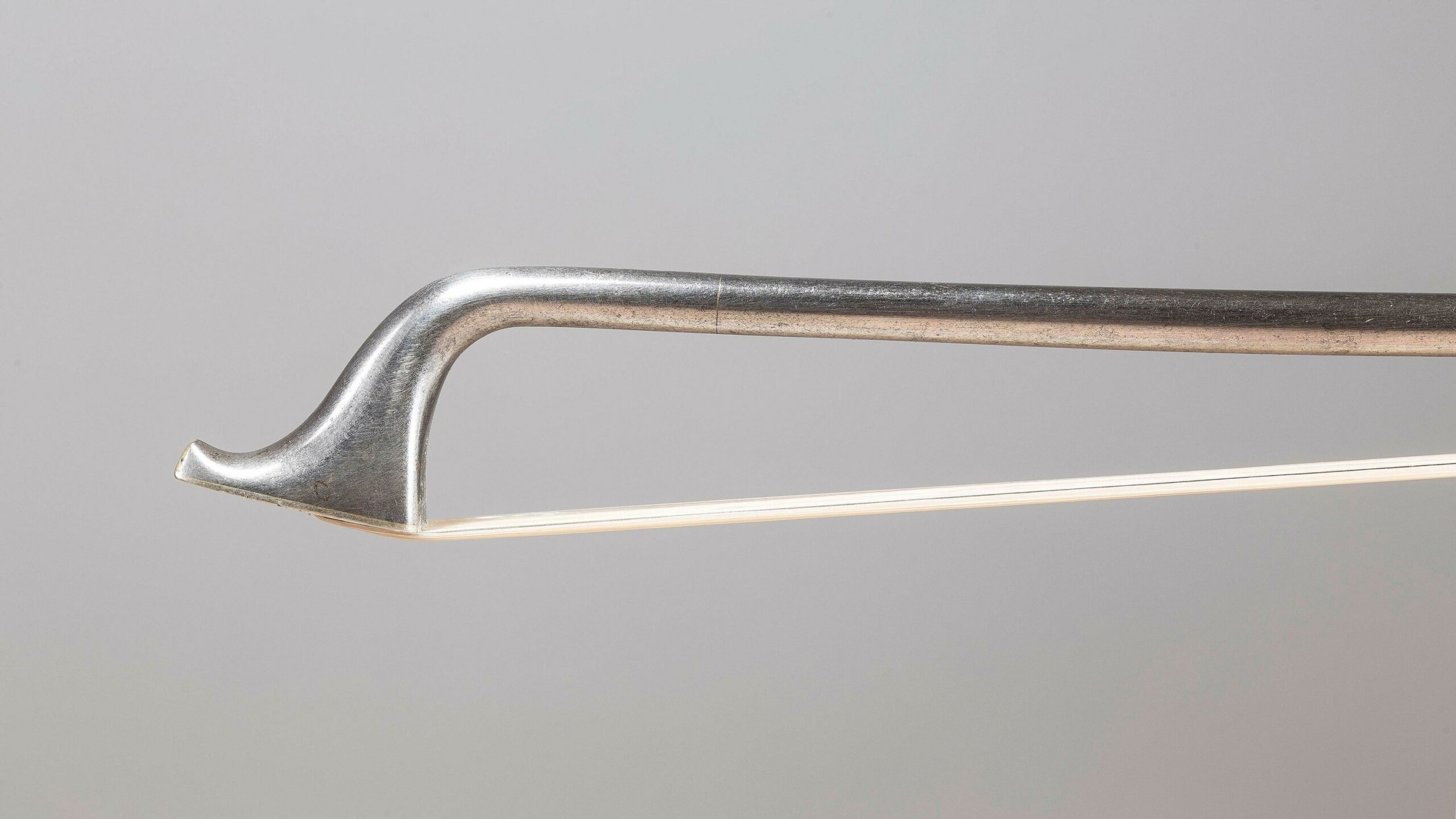
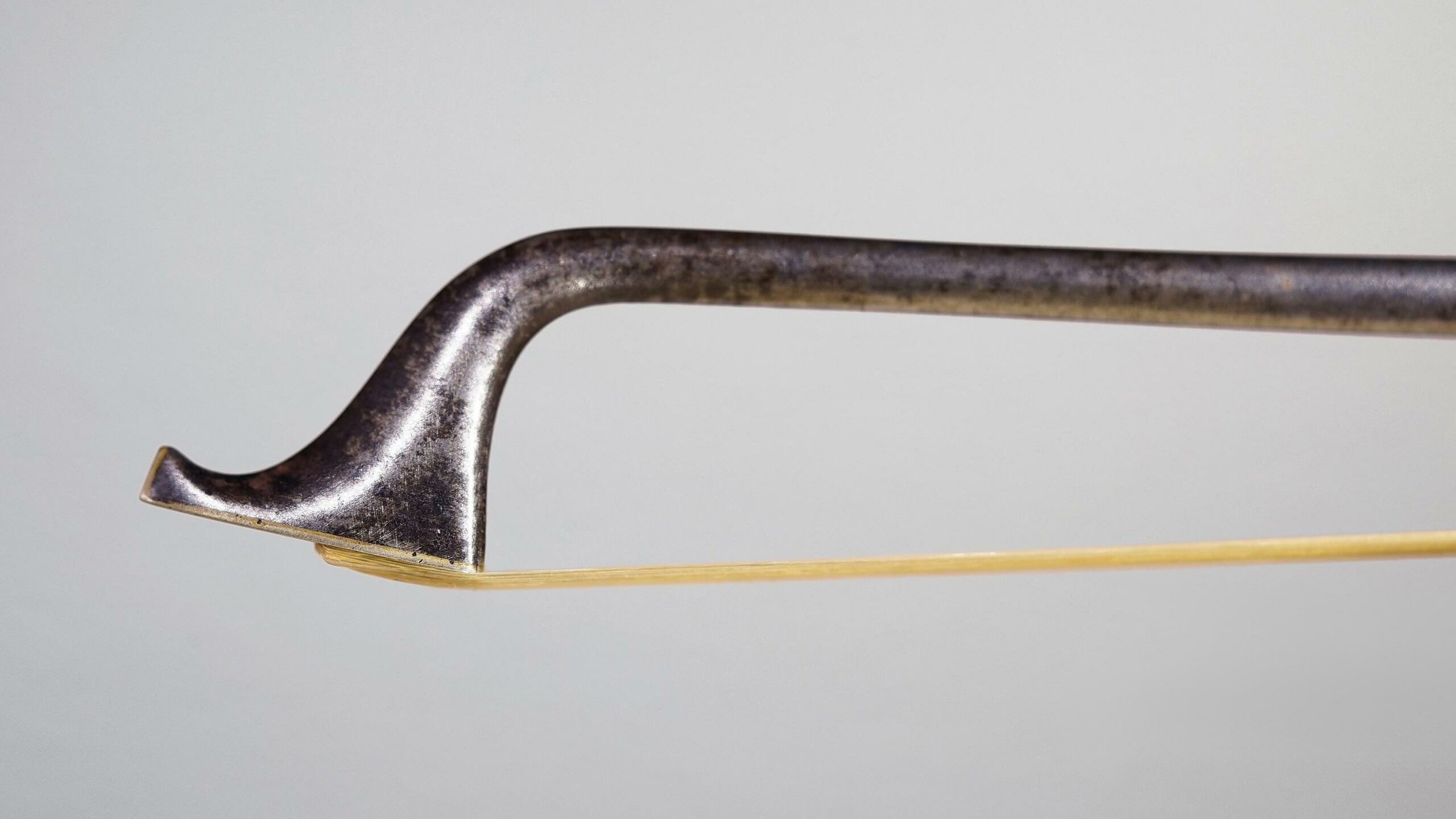
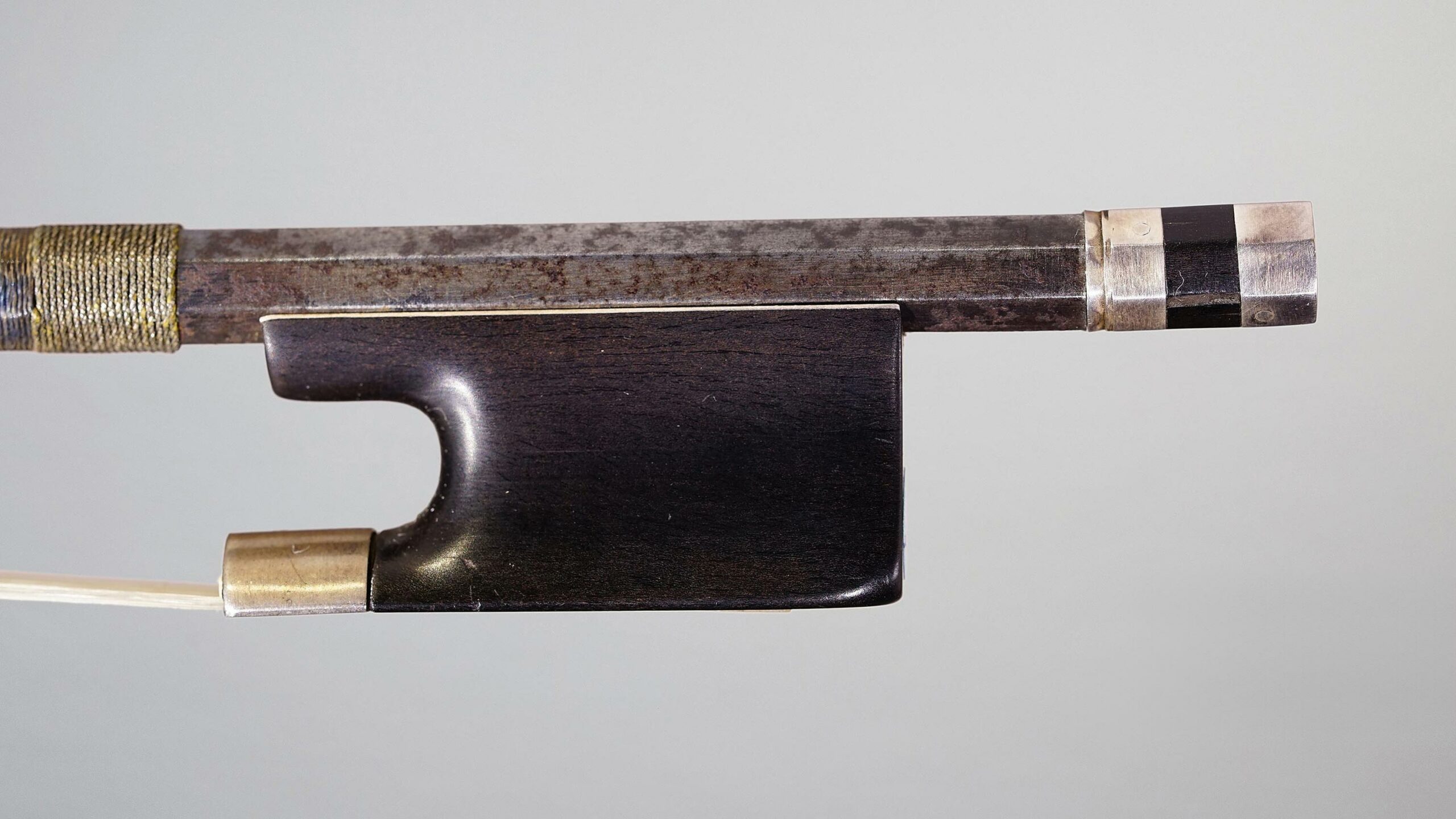
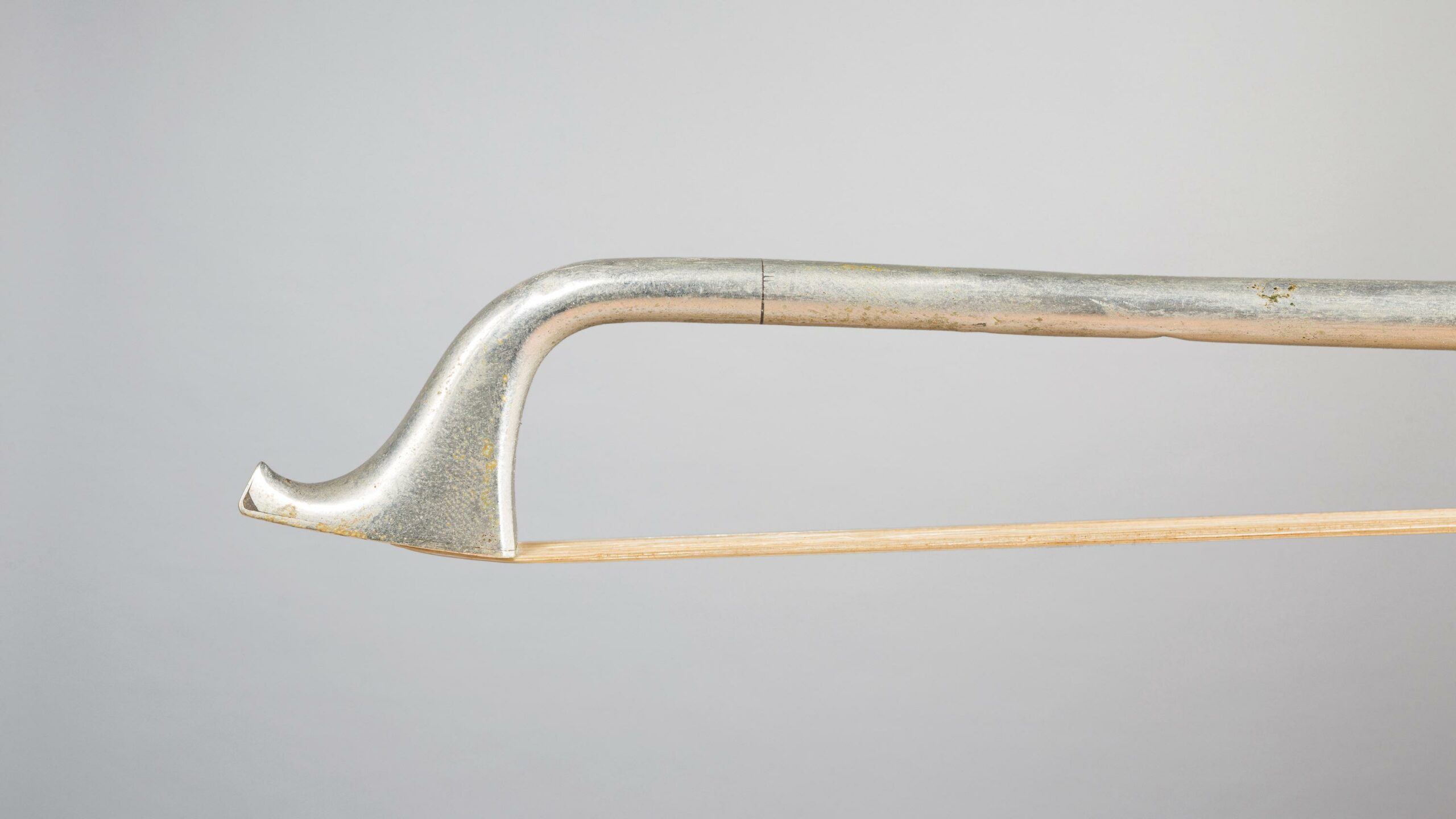
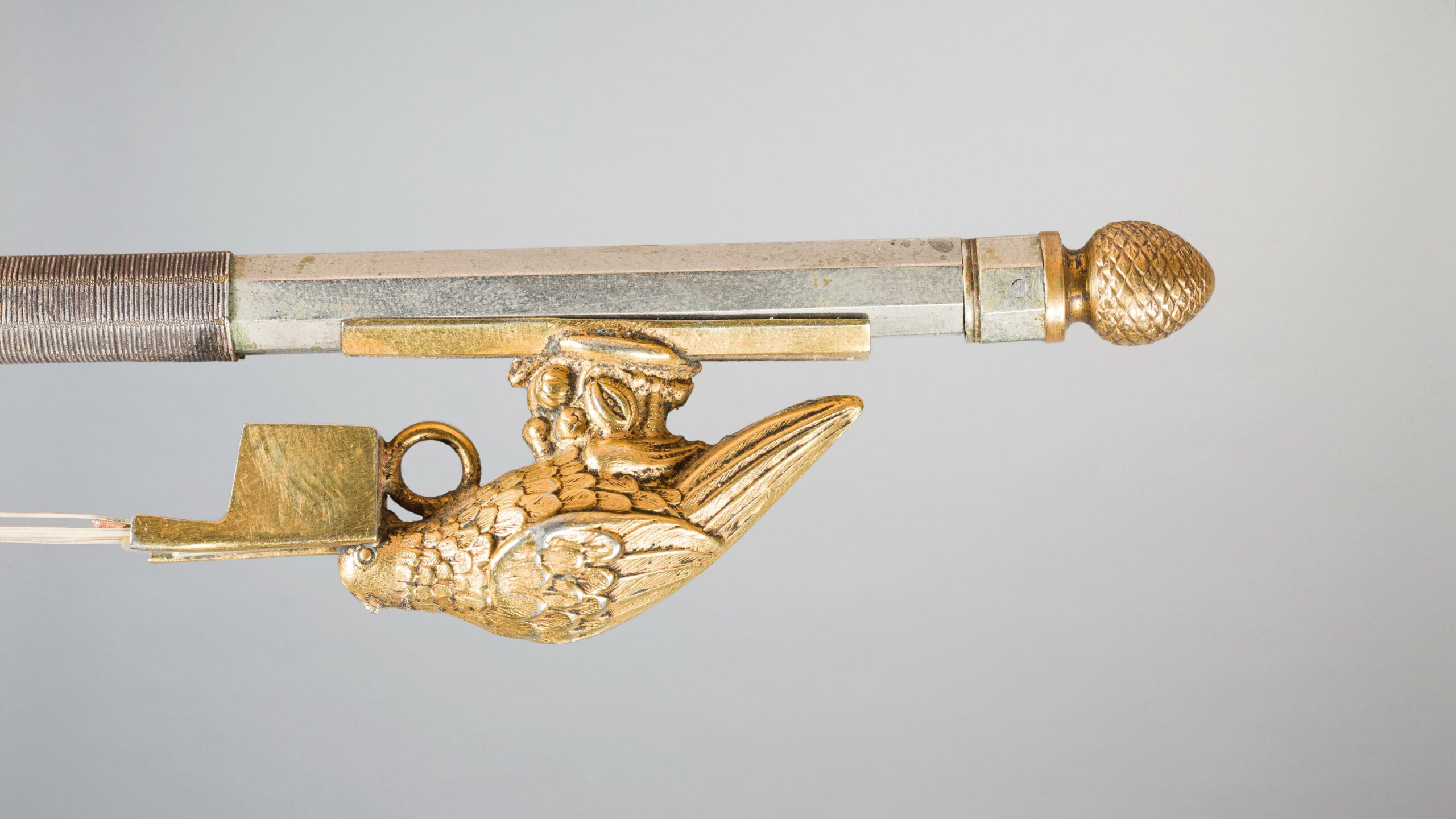
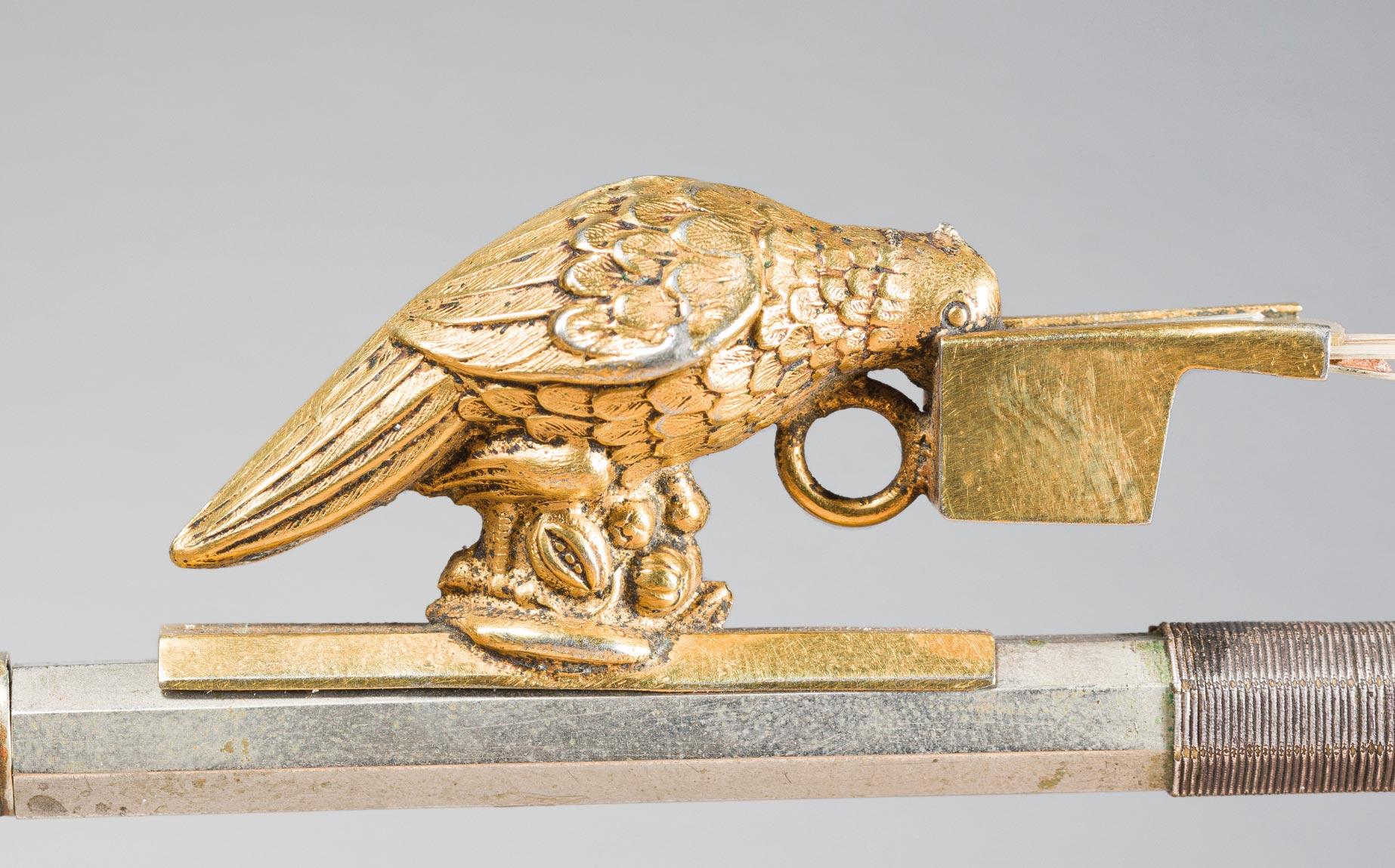
Le modèle de la vente Vichy Enchères du jeudi 5 décembre 2024 est particulièrement remarquable puisqu’il s’agit du seul archet en métal à avoir une hausse figurative.
“Il s’agit d’un archet unique à caractère d’exception dans la production de Vuillaume !
C’est le seul que nous lui connaissons présentant ce motif d’oiseau sur la hausse. C’est d’ailleurs le seul archet connu avec une hausse figurant un oiseau. C’est une rareté de l’archeterie.”
Sylvain Bigot et Yannick Le Canu, experts en archets, le 30 septembre 2024
Comme le signalait déjà Sylvette Milliot dans son ouvrage sur les luthiers parisiens à propos des archets de Vuillaume, il s’agit en effet d’un instrument très rare :
“Dans certains exemples très rares elles [les hausses] peuvent même perdre leurs formes habituelles au profit d’un dessin particulier : tel ce lion accroupi en ivoire tenant la mèche dans ses narines pour un archet réalisé par Nicolas Maline, ou cet oiseau en métal picorant dans une mangeoire pour un archet à baguette en acier creux.”
Sylvette Milliot, Les luthiers parisiens aux XIXe et XXe siècles : Jean Baptiste Vuillaume et sa famille : Nicolas, Nicolas-Franc̦ois, Sébastien, 2006, p 309
Cet extrait fait allusion à deux modèles exceptionnels de la production de Vuillaume – à savoir un archet à hausse Vuillaume représentant un lion assis, réalisé par Maline alors qu’il travaillait dans l’atelier de Vuillaume (collection J. et A. Beare, Londres)[1] ; et l’archet métallique de la vente Vichy Enchères du 5 décembre 2024, ayant pour hausse un perroquet naturaliste. Celui-ci est figuré perché sur un petit monticule de graines, le bec plongé dans un abreuvoir à partir duquel sont attachées les mèches de l’instrument.
[1] Violins, Vuillaume 1798-1875, un maître luthier français du XIXe siècle : Paris, Cité de la musique/Musée de la musique, 23 octobre 1998-31 janvier 1999
Cet archet métallique, tout à fait exceptionnel dans la carrière de Vuillaume, avait à ce titre était exposé à Paris, dans la Grande Halle de la Villette, lors du bicentenaire de la naissance de Vuillaume. Véritable prouesse technique et artistique, l’instrument avait d’ailleurs été choisi pour faire la couverture du catalogue de l’exposition. Les photos de l’archet présentées dans le catalogue (et également dans L’Archet de Millant et Raffin) nous permettent de constater que depuis, le bouton a été changé.
Un autre innovation majeure de Vuillaume en archèterie fut le développement de la « hausse Vuillaume », conçue dans le but d’améliorer la conservation des archets. Vuillaume constata en effet que les hausses traditionnelles étaient souvent sujettes à des modifications indésirables sur le long terme, affectant le jeu et la sonorité des instruments.
Il introduisit alors, vers 1845, une nouvelle hausse caractérisée par un passant arrondi et une coulisse ronde dotée de retours latéraux.
L’un des premiers à avoir adopté cette innovation est Nicolas Maline, bien qu’il modifia le passant pour le rendre plus plat et long. À partir de 1855, François Nicolas Voirin, cousin de Vuillaume, prit le relais et perfectionna la fabrication de ces hausses. C’est notamment Charles Peccatte qui, sous la direction de Voirin, réalisa les archets à hausse Vuillaume jusqu’en 1870.
L’une des caractéristiques les plus intéressantes des archets à hausse Vuillaume est l’utilisation de la micro-photographie, une technique que Vuillaume fut l’un des premiers à intégrer lors de son invention. On trouve ainsi, dans certains archets d’exception, de minuscules portraits insérés au centre des grains de nacre de la hausse, représentant fréquemment Vuillaume ou des musiciens célèbres de l’époque tels que Paganini ou Sarasate[1].
“A-t-il confié à quelque spécialiste hausse et photographie de dimensions courantes pour exécuter entièrement le travail ? Prenait-il chez le fournisseur la microphotographie avec les lentilles et faisait-il placer le tout dans la hausse par ses archetiers ? Cela semble plus probable.”
Sylvette Milliot, Les luthiers parisiens aux XIXe et XXe siècles : Jean Baptiste Vuillaume et sa famille : Nicolas, Nicolas-Franc̦ois, Sébastien, 2006, p 309
Ces photographies, visibles grâce à une lentille grossissante, conféraient aux archets un caractère unique et prestigieux, attestant d’une certaine extravagance propre à la personnalité de Vuillaume.
[1] Bernard Millant, Jean François Raffin, L’Archet, tome II, L’Archet Editions, 2000
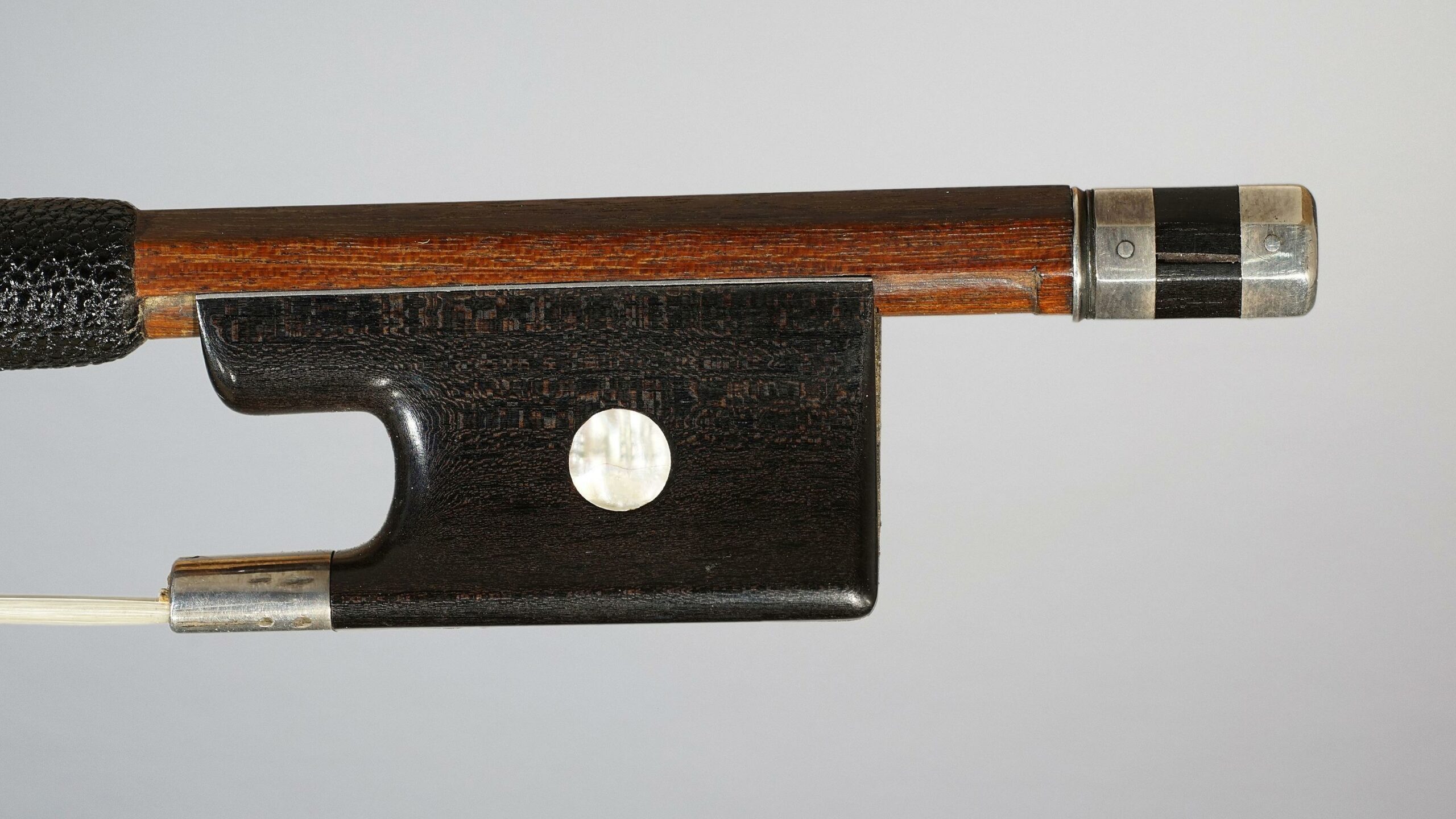
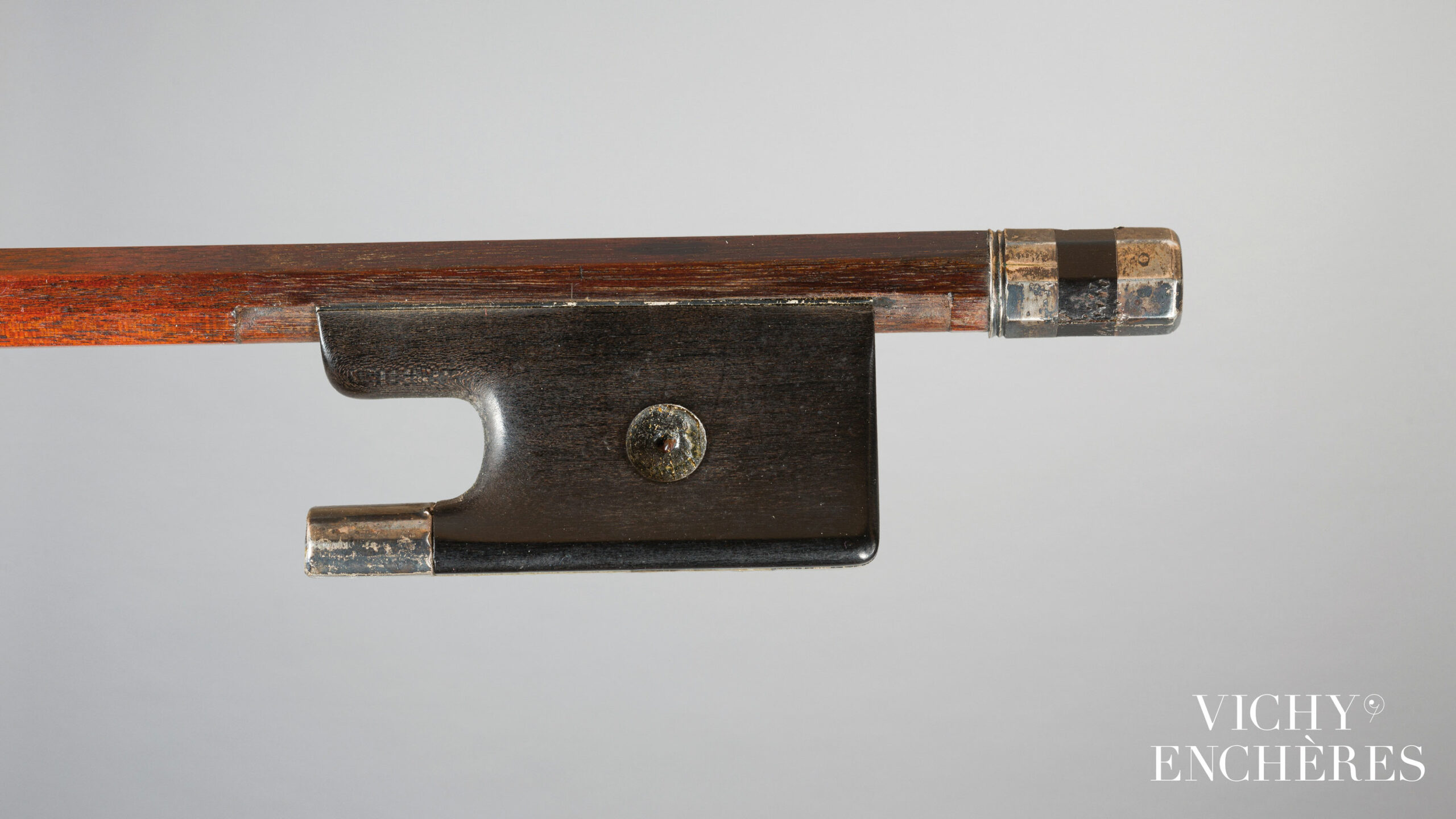
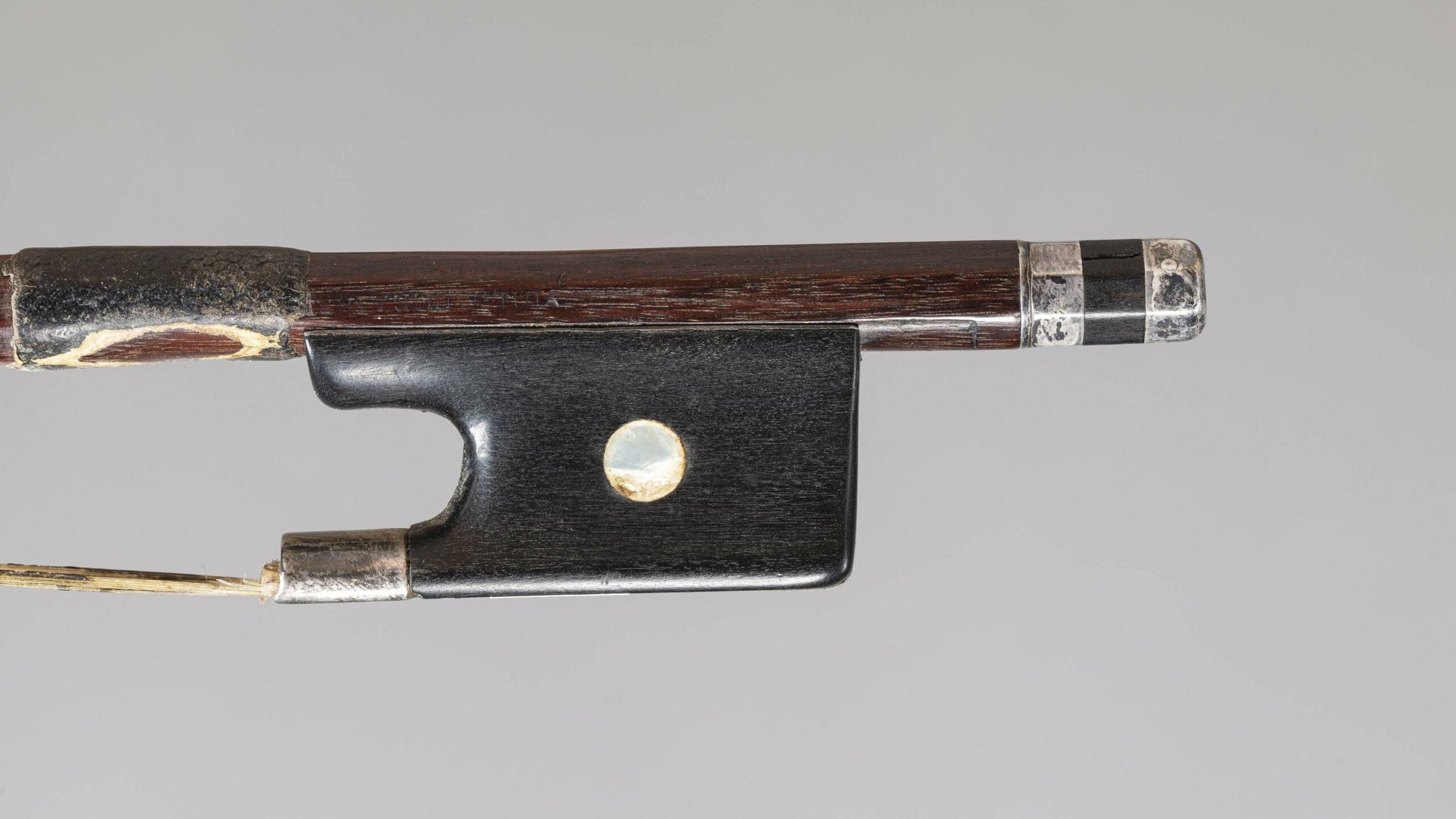
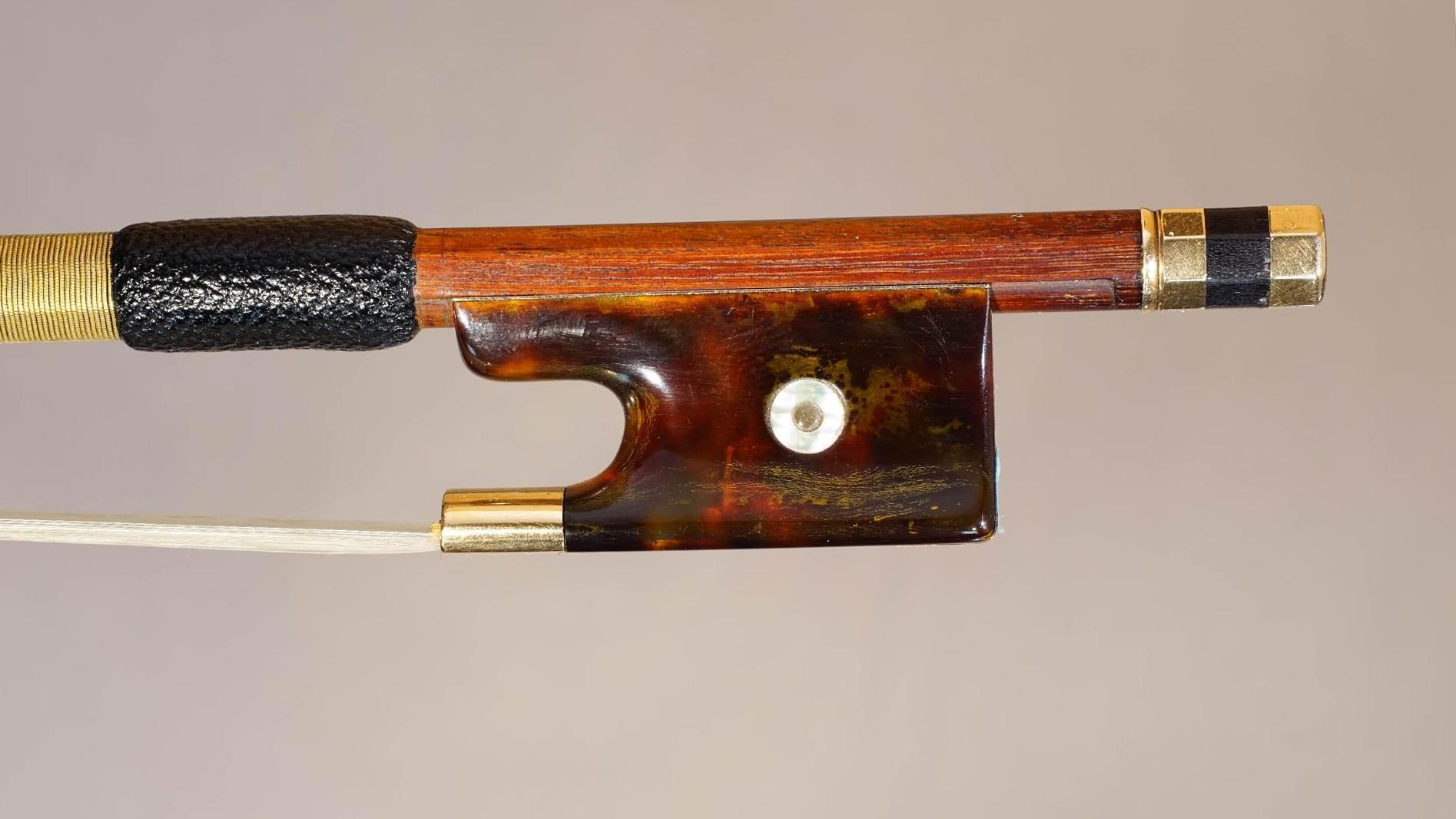
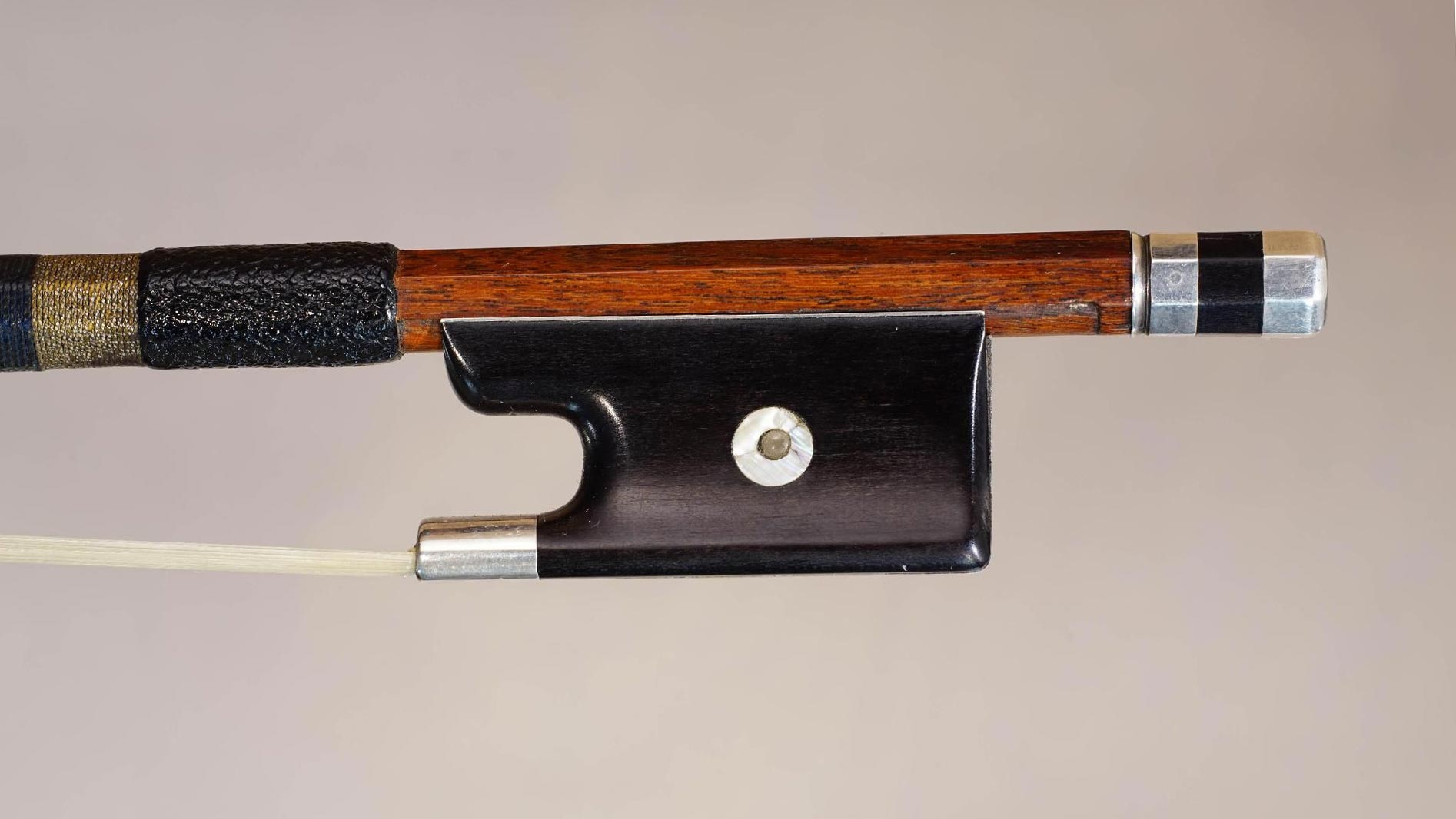
Vuillaume comprit très vite que pour mener à bien ses innovations, il devait s’entourer des meilleurs talents de son temps. Il forma ainsi une multitude de jeunes gens, majoritairement en provenance de Mirecourt. Dès les années 1830, Vuillaume dirigeait plusieurs ateliers employant luthiers et archetiers. Parmi lesquels, Jean-Pierre Marie Persoit, Claude Joseph Fonclause, Dominique et François Peccatte, Nicolas Maire, Nicolas Maline, Pierre Simon et François Nicolas Voirin.
Ces derniers jouèrent un rôle clé dans l’évolution de l’archèterie française au XIXe siècle et devinrent, chacun à leur manière, des figures emblématiques de la profession.
Sous sa direction, l’atelier devint un véritable laboratoire d’innovations. Vuillaume chargea notamment Voirin d’élaborer un système mécanique pour dégrossir les baguettes.
Cette émulation créatrice permit à l’archèterie française de dominer le marché européen au XIXe siècle et de poser les bases de l’archèterie moderne.
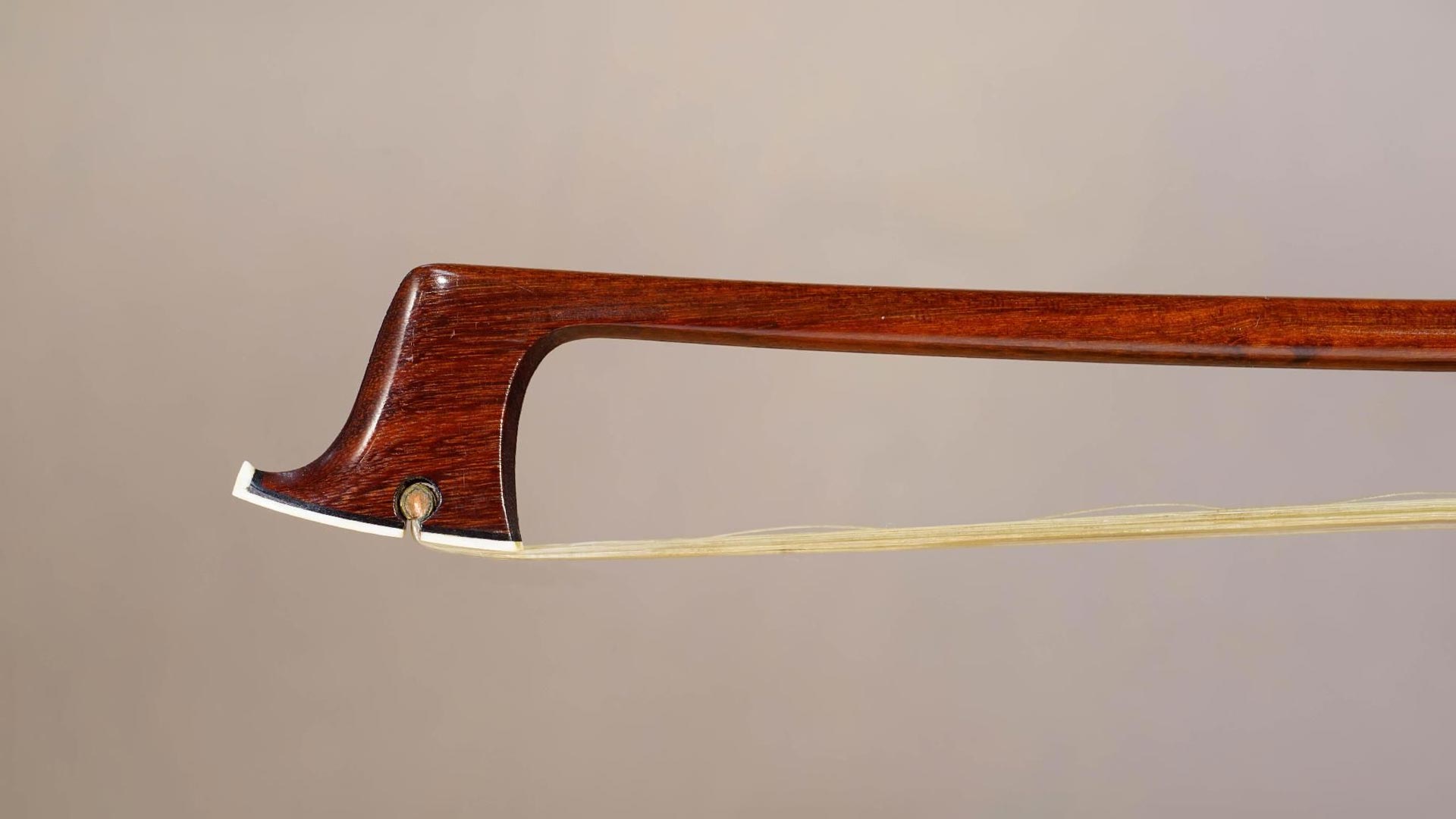
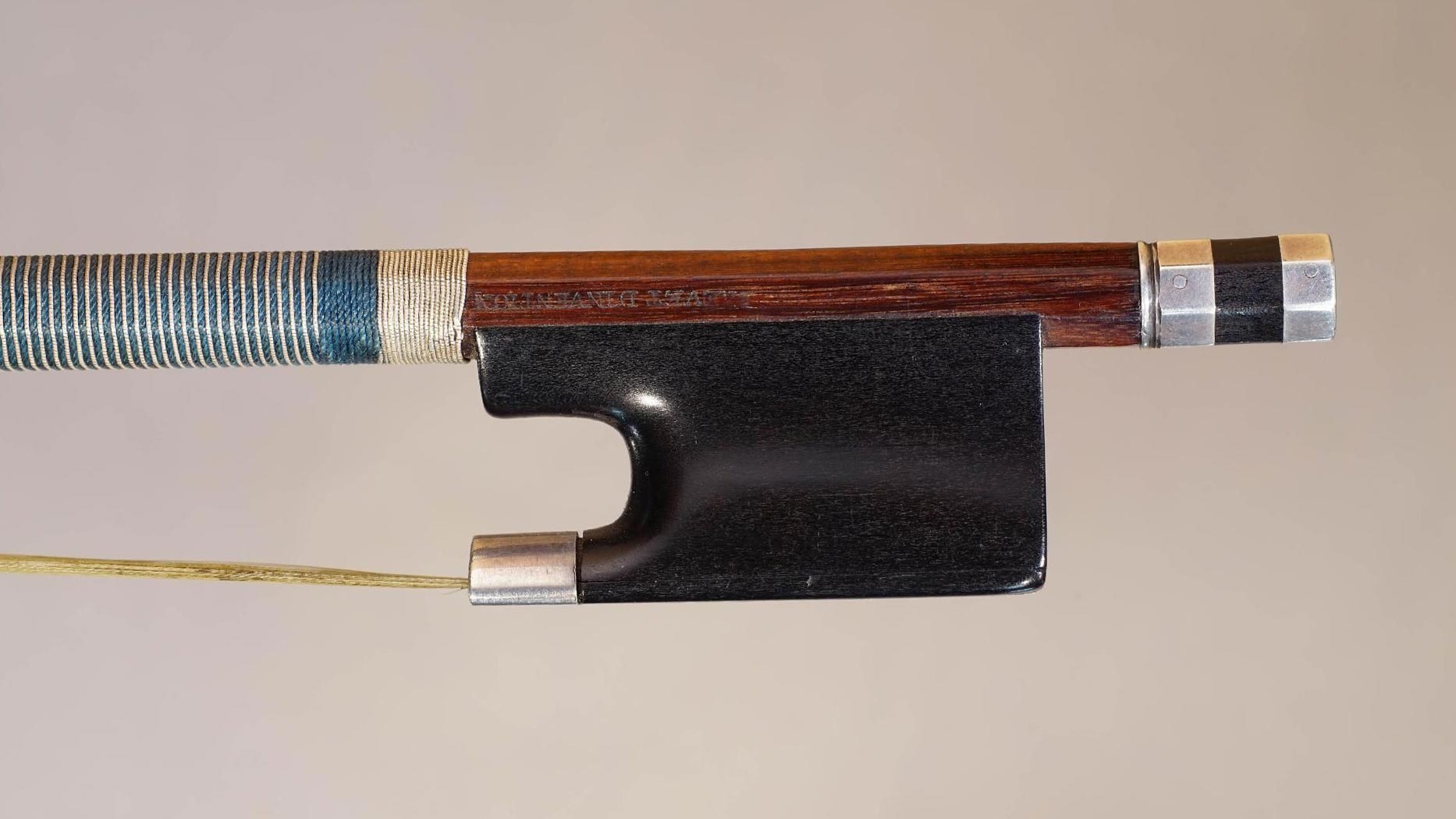
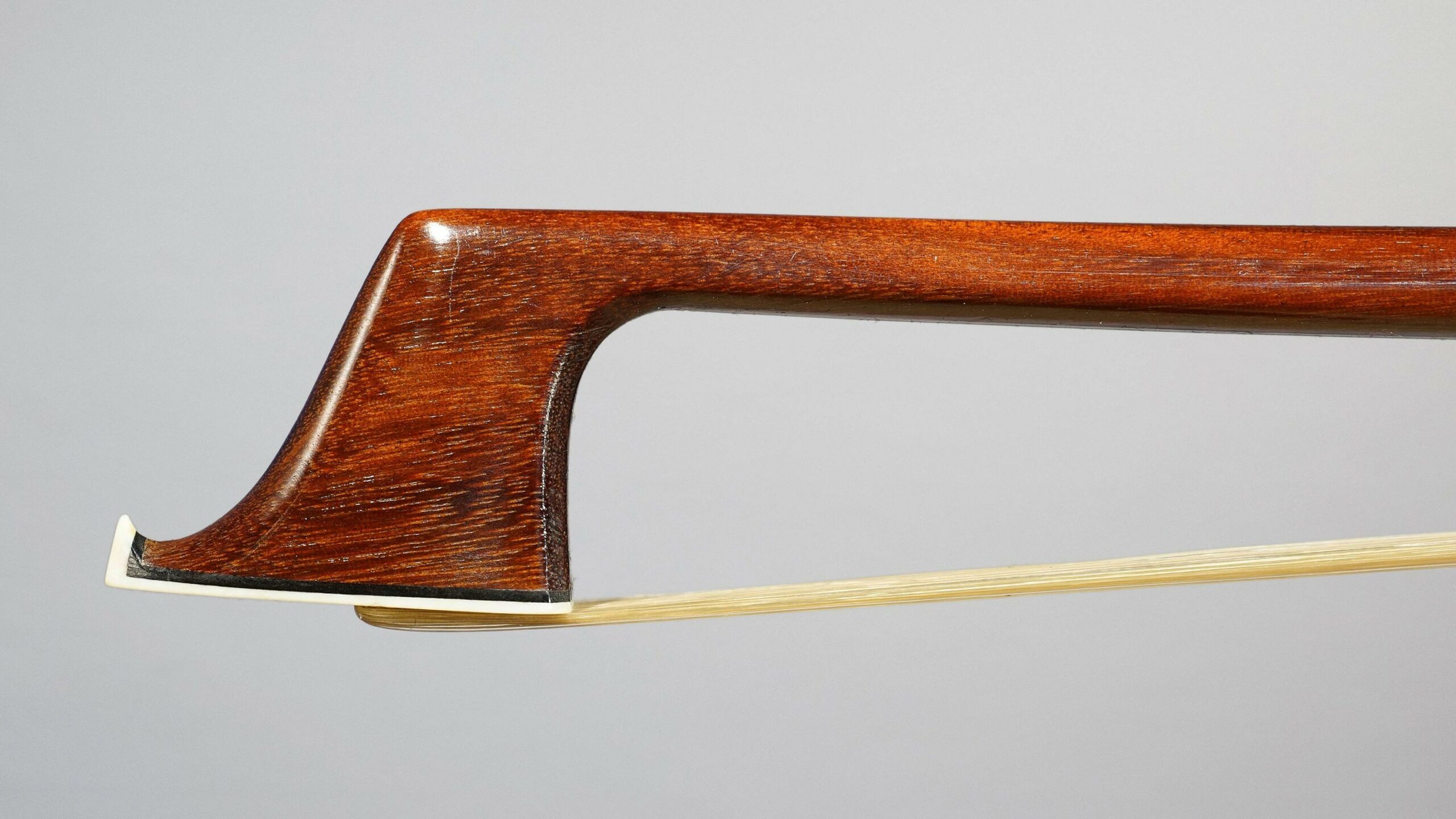
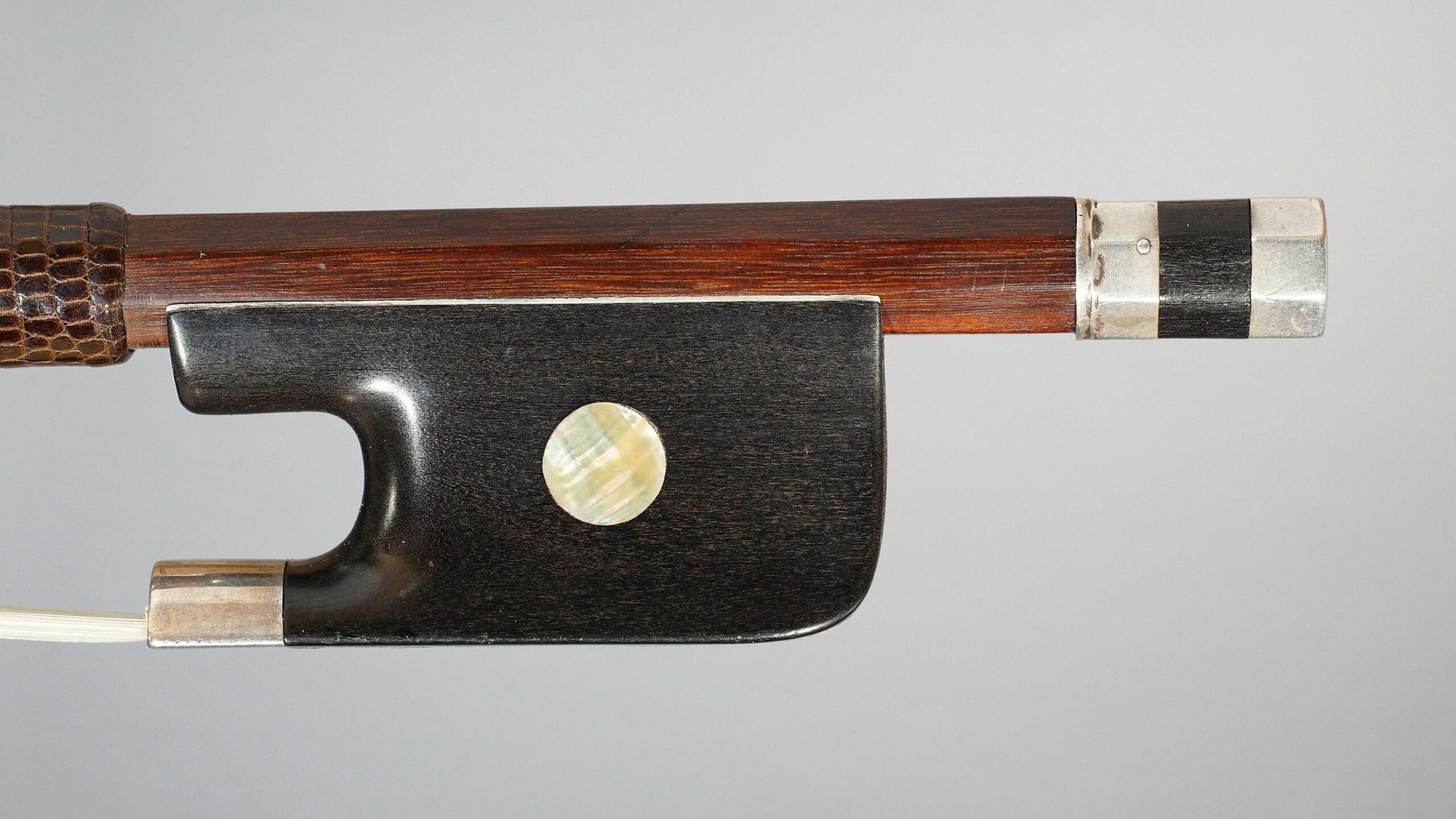
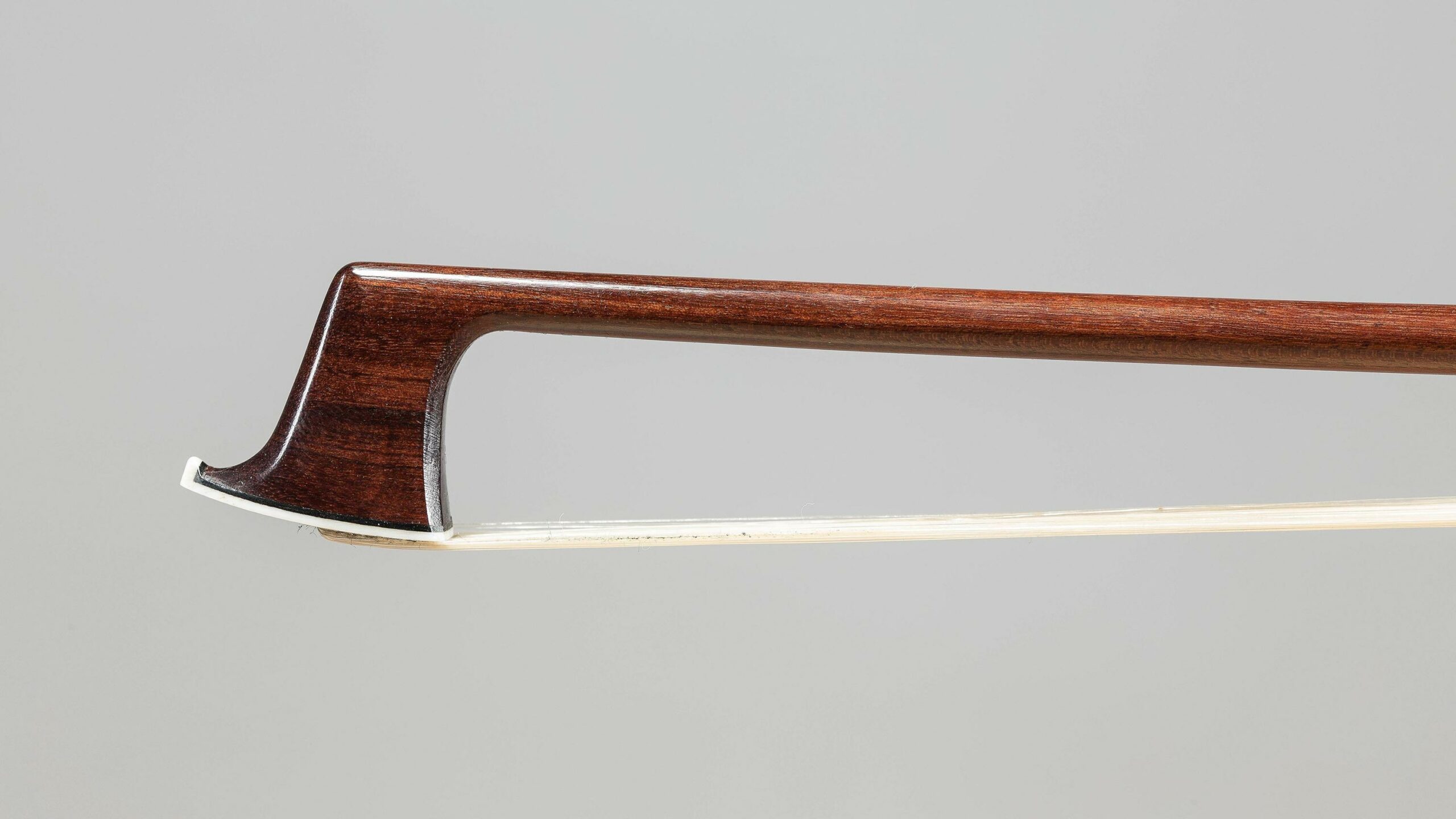
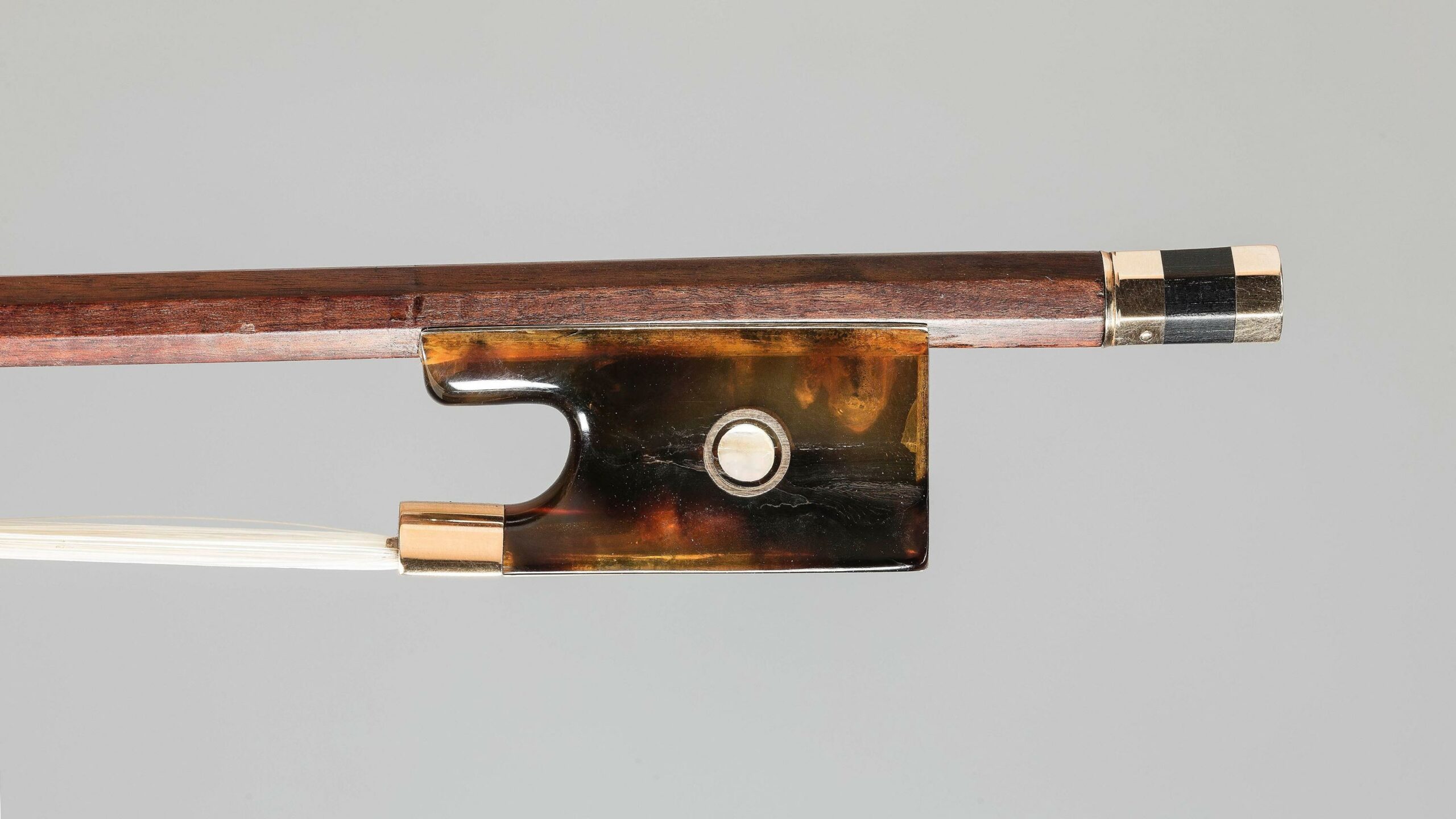
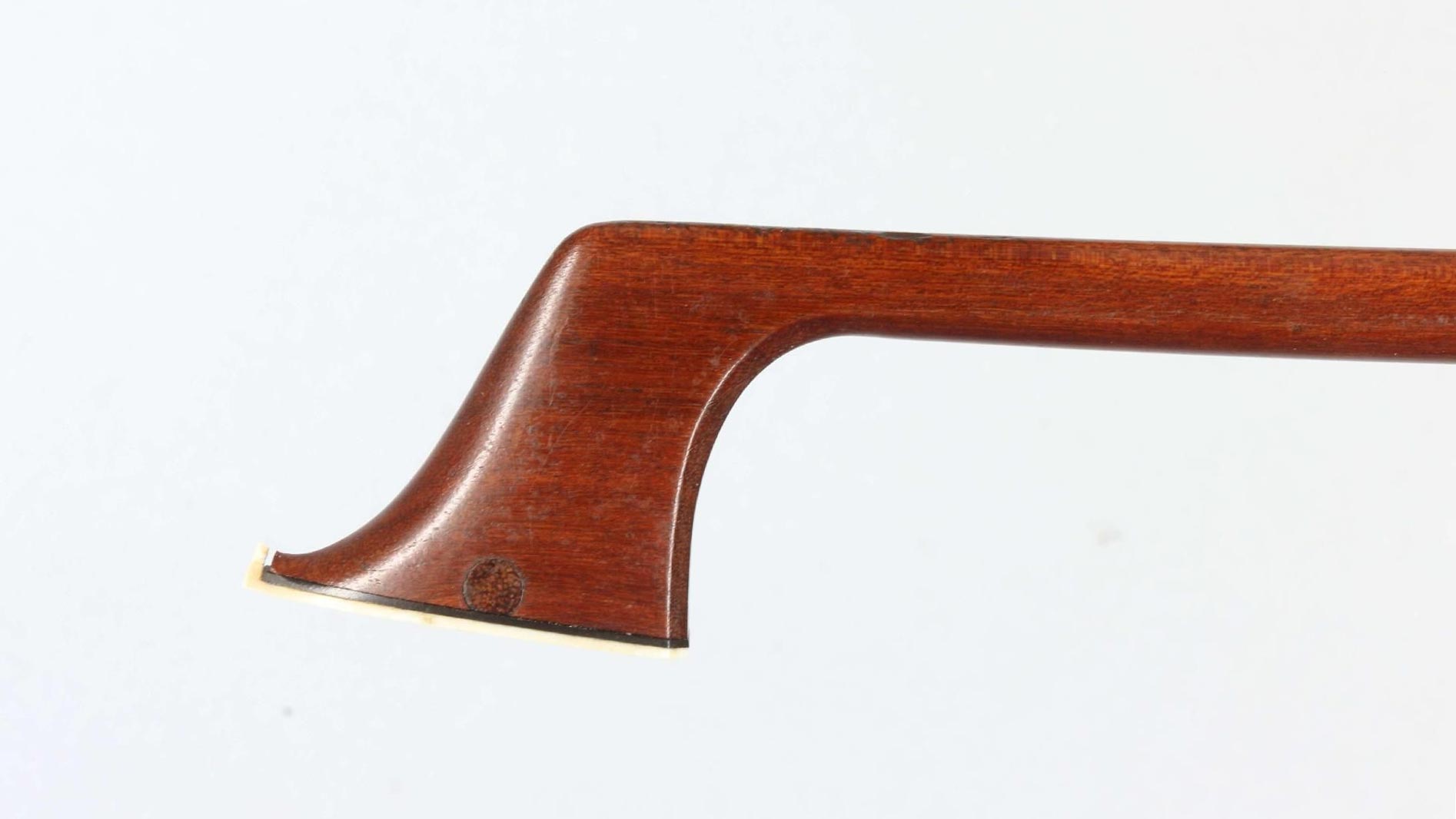
Jean-Baptiste Vuillaume fait incontestablement partie des luthiers-archetiers les plus inventifs de son temps. Son esprit créatif, combiné à un désir constant de perfectionner les instruments, marqua à jamais l’histoire de l’archèterie, que ce soit à travers l’invention de l’archet à mèche interchangeable, de la hausse Vuillaume, ou encore de l’archet en métal, dont Vichy Enchères vendra le 5 décembre 2024 le plus exceptionnel des modèles jamais réalisés : un petit bijou ayant en guise de hausse…un perroquet !
Vichy Enchères is delighted to present at auction on 5 December 2024 an exceptional bow by Jean-Baptiste Vuillaume, which constitutes a unique example in the history of bow making. This bow made of metal, which is a true technical and artistic feat, stands out for a rare feature on its frog, which is adorned with a naturalistic representation of a drinking bird, a detail not found throughout the rest of Vuillaume’s work. This bow is a masterpiece of innovation and refinement, and is not only unique in Vuillaume’s output, but also in the history of bow making, as it is the only known example which such decorative feature. Let’s take this opportunity to revisit the innovative and creative bow making career of Vuillaume.


Jean-Baptiste Vuillaume (1798-1875) was born into a family of violin makers from Mirecourt, and continued the centuries-old family tradition. Although the identity of his master is unclear – it could have been Joseph Chanot, Nicolas Mathieu, or even Simoutre père – we do know that Vuillaume left Mirecourt for Paris in 1818, where he worked first for François Chanot, and then Nicolas Antoine Lété. In Paris, his precocious talent was quickly recognized.
Lété won a medal at the 1823 Paris Exhibition for a violin made by Vuillaume, and allowed the young violin maker to sign his works under his own name and achieve greater recognition. In 1828, Vuillaume opened his own workshop at 46 rue Croix-des-Petits-Champs, which marked the beginning of his rise to fame in the world of violin making. He made a name for himself as a violin maker first, with his instruments being compared to those of the greatest Italian masters such as Stradivari and Guarneri, but also as an innovative bow maker.
The bow with interchangeable hair is amongst Vuillaume’s most famous inventions. It allowed musicians to change the hair of their bows themselves, without the need of a bow maker. It was an innovation particularly appreciated by musicians living in rural or remote areas, where access to bow makers was limited.
The principle of this bow was simple but ingenious: the hair was fitted at both ends into copper tubes. To replace the hair, these tubes could simply be removed from their specially designed slots in the bow head and frog and replaced with new ones. The hair tension mechanism, located in the frog, allowed the musician to tighten the hair as desired.
Vuillaume sold these bows with a box containing several replacement hairs, as well as an instruction manual. The instructions included practical information on how to prevent the bow from warping when fitting new hair. If the bow warped after replacement, Vuillaume’s instruction was to simply turn over the hair to correct the problem.
There was high demand for this new system, particularly from travelling musicians, who could avoid long journeys to major cities to have their bows rehaired. However, the system wasn’t without its drawbacks. The slot in the head of the bow to accommodate the hair tube weakened the structure of the head, making it more prone to cracks. In addition, the frog could come unglued due to moisture from the musician’s hand, thus compromising the stability of the bow.
Vuillaume filed a patent for his invention on 30 November 1835, and the bow with interchangeable hair remained in production for approximately 15 years before Vuillaume decided to discontinue it around 1850.
Of Vuillaume’s many inventions, the metal bow, designed in 1834, is probably the most daring and controversial. Bows are traditionally made of wood, usually pernambuco, and Vuillaume sought to introduce an alternative made from a more durable material. His goal was to create a bow that would not warp over time, as wood does.
Vuillaume’s first metal bows were made from hollow steel or nickel silver tubes. These materials offered great strength and did not bend under pressure, unlike wood. Vuillaume claims to have sold 5,560 of these bows between 1834 and 1850, which is an impressive figure demonstrating the high interest in this innovation from its outset[1].
[1] Bernard Millant, Jean François Raffin, L’Archet, tome II, L’Archet Editions, 2000
As experts Sylvain Bigot and Yannick Le Canu point out, these bows were not produced in Vuillaume’s workshop but externally, by craftsmen specializing in metalwork.
However, this new bow also had its limitations. Metal did not have the same flexibility as pernambuco wood, thus limiting the ability to achieve optimal curvature and resonance when playing the bow. The main challenge was to correctly bend the bow without negatively impacting its shape and strength. Furthermore, the tendency of metal to rust and oxidize over time deterred many musicians.






The example in the Vichy Enchères sale on Thursday 5 December 2024 is particularly remarkable as it is the only metal bow to feature a decorated frog.
“This is a unique bow of exceptional character in Vuillaume’s output!
It is the only one we know of with this particular bird motif on the frog, or any bird motif for that matter. It is a rarity in bow making.”
Sylvain Bigot and Yannick Le Canu, bow experts, 30 September 2024
As Sylvette Milliot, in her book on Parisian luthiers, also previously indicated with respect to Vuillaume bows, this is indeed a very rare bow:
“In some very rare cases, they [the frogs] can even lose their traditional shapes in favour of a particular design, such as this crouching ivory lion holding the hair in its nostrils on a bow made by Nicolas Maline, or this metal bird pecking in a bird feeder on a bow with a hollow steel stick.”
Sylvette Milliot, Les luthiers parisiens aux XIXe et XXe siècles : Jean Baptiste Vuillaume et sa famille : Nicolas, Nicolas-Franc̦ois, Sébastien, 2006, p 309
This extract refers to two exceptional examples in Vuillaume’s output: a Vuillaume bow with a frog representing a seated lion, made by Maline while he was working in Vuillaume’s workshop (J. and A. Beare Collection, London)[1] ; and the metal bow in the Vichy Enchères sale on 5 December 2024, featuring a naturalistic representation of a parrot as its frog. The latter is depicted perched on a small mound of seeds, its beak immersed in a water bowl from which the bow hair is attached.
[1] Violins, Vuillaume 1798-1875, un maître luthier français du XIXe siècle : Paris, Cité de la musique/Musée de la musique, 23 octobre 1998-31 janvier 1999
This metal bow, which is quite unique in Vuillaume’s production, was exhibited in Paris, in the Grande Halle de la Villette, for the bicentenary of Vuillaume’s birth. This true technical and artistic prowess featured on the cover of the exhibition catalogue. The photos of the bow presented in the catalogue (and also in L’Archet by Millant and Raffin) show that the button has since been replaced.
Another major bow making innovation developed by Vuillaume was the « Vuillaume frog », which was designed to prolong the life of bows. Vuillaume noticed that traditional frogs were often the subject of undesirable restoration over time, which affected the playability and sound production of bows.
Around 1845, he introduced a new frog featuring a rounded ferrule and a round slide with curved edges.
One of the first to adopt this innovation was Nicolas Maline, albeit with some modifications, as he made the ferrule flatter and longer. From 1855, François Nicolas Voirin, Vuillaume’s cousin, took over the manufacture of these frogs and improved on their design. Furthermore, Charles Peccatte, while working for Voirin, produced bows with Vuillaume frogs until 1870.
One of the most interesting aspects of bows with Vuillaume frogs is their use of microphotography, a technique of which Vuillaume was an early adopter upon its advent. Therefore, on some exceptional bows, tiny portraits are found inserted into the centre of the frog’s mother-of-pearl eye, often depicting Vuillaume or famous musicians of the time, such as Paganini or Sarasate.[1].
“Did he commission a specialist to carry out this intricate task, by providing them a frog and a standard size photograph, or did he order from a supplier the microphotograph with the lenses, and have his bow makers insert them in the frog? The latter seems more likely.”
Sylvette Milliot, Les luthiers parisiens aux XIXe et XXe siècles : Jean Baptiste Vuillaume et sa famille : Nicolas, Nicolas-Franc̦ois, Sébastien, 2006, p 309
These photographs, visible through a magnifying glass, gave the bows a unique and prestigious character, and attest to a certain extravagance characteristic of Vuillaume’s personality.
[1] Bernard Millant, Jean François Raffin, L’Archet, tome II, L’Archet Editions, 2000





Vuillaume quickly understood that, to successfully implement his innovations, he needed to surround himself with the best talent of his time. He therefore trained a multitude of young cratfsmen, mostly from Mirecourt. By the 1830s, Vuillaume ran several workshops employing violin and bow makers. Amongst them were Jean-Pierre Marie Persoit, Claude Joseph Fonclause, Dominique and François Peccatte, Nicolas Maire, Nicolas Maline, Pierre Simon, and François Nicolas Voirin.
These apprentices played a key role in the evolution of French bow making in the 19th century, and became iconic figures of the trade in their own right.
Under his leadership, the workshops became true experimental laboratories. In particular, Vuillaume commissioned Voirin to develop a mechanical system for roughing out sticks.
The creative competition that stemmed from these circumstances led France to dominate European bow making in the 19th century and lay the foundations for modern bow making.







Jean-Baptiste Vuillaume is undoubtedly one of the most inventive violin and bow makers of his time. His creative spirit, combined with a constant search for perfection, forever marked the history of bow making, whether through the invention of the bow with interchangeable hair, the Vuillaume frog or the metal bow, such as the one in the Vichy Enchères sale on 5 December 2024, which is the most exceptional example ever made: a little gem that features, instead of a frog, a parrot!